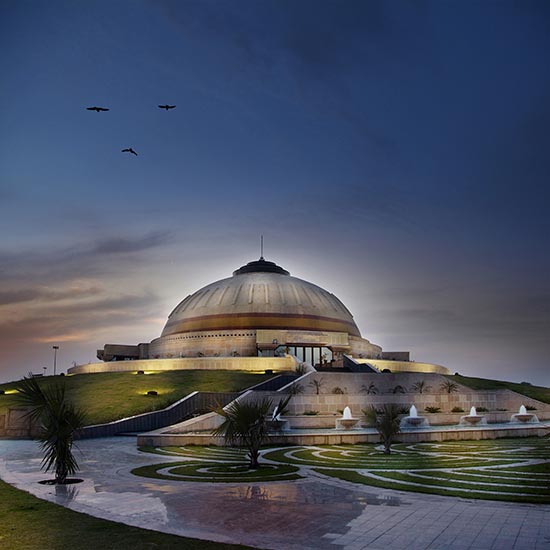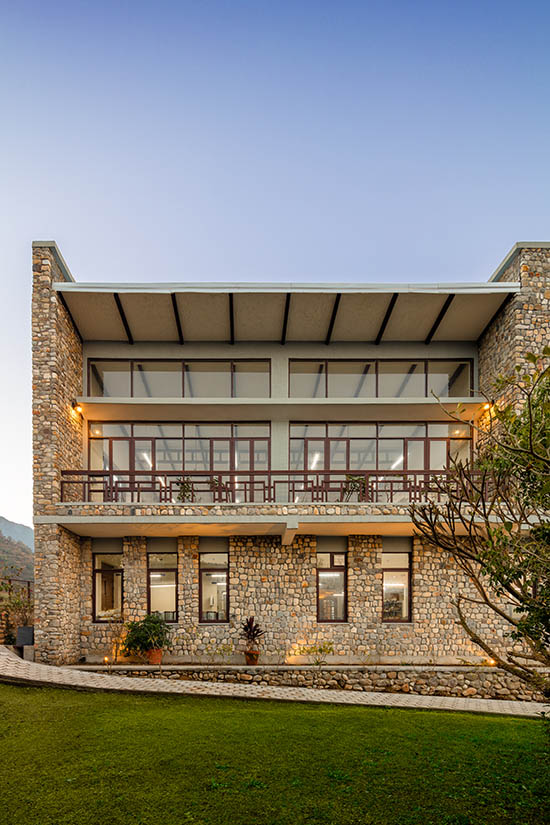
Architectural Group: Archohm, Noida
Principal Architect: Sourabh Gupta
Project Location: Noida, Uttar Pradesh
Client: The Design Village Foundation
Consultants: Roark Engineers Consulting, Techno Engineering Consultants, Archohm Consults
Project Completion: 2014t.
Project Type: Institutional Project
Image Courtesy: Humayun Khan
The entire work space is conceived as a vibrant and active space, interspersed with distinctive mediations, unique, out-of-the box ideas to inspire creativity amongst the students. The design of the campus is
Driven by the pedagogical vision of TDV- ‘Life through Design’ that is based on the learning journey undertaken by the student that encourages personal development while creating/making/having an impact – on the individual, the society and the environment at large.
Conceived as a global hub that educates, promotes and supports development through design, the interdisciplinary institute with a focus on design and practice is designed as a village in all aspects, ‘by bringing in the flavour of a mix of institutes, associations, studios, industries and centres.
As one enters, one is greeted by a sunken amphi-theatre that serves as an interesting gathering space for students during their break times as well as for outdoor seminars, plays etc. Surrounded by lush green cover around, this stoned terraced space beautifully merges with the landscape of the exterior. The zone, is surrounded by interesting trees and shrubs, natural materials and punctuated with inviting benches and steps.
The step-well stone masonry structure embraces a set of guest rooms at its base. These guest rooms are furnished with kitchenettes and other necessities and are cleverly tucked into the basement of a concrete triangular volume above, which forms a part of the Archohm fortress – the larger eco system which encompasses the design village belongs.
As a conversation starter, a sedan is mounted vertically on the wall atop the stage of the amphitheater. The car headlights serve as an interesting light source for the space. Installed as a sculpture, the car once belonged to one of the founders and the design dean of TDV- Mr. Sourabh Gupta, who refused to part with it. The car was relieved of its engine and put high up on the concrete wall. Its number plate reads 12052014, and stands for the day the design village was borne. The car is an interesting comment on the everyday object being elevated to the status of art.
A temporary bamboo food basket perched in a corner serves as a peaceful, contemplative space, that almost reminds one of a confessional, in essence – a place for revelation.
Going down a narrow fleet of stairs with thick stone wall cladding the entry walk, one is led into an open reception area with half glass walls that add transparency to the space and enable a quick visual connect with the studio spaces. A small meeting room abuts the reception desk. A linear waiting area is planned across the reception for visitors that overlook a live size tag board that contain the important notices and schedules of the institute.
The glass door of the waiting space, urges the visitor to enter into an expanse of studio spaces, divided by glass walls that double up as writing surfaces as well. In order to maintain the privacy as well as the fluidity in space, glass stickers are used. The pattern of these stickers is inspired by TDV’s DNA circular structure of an actual dna (Deoxyribonucleic acid) symbolizing the philosophy of Life Through Design
On entering the learning spaces; a 15 feet long blackboard wall welcomes the visitor, with some brainstorming charts/doodles etc.
A column grid is seen partitioning the spaces. Each column is either a blackboard or a tag board.
The sheer division of program with glass walls interestingly divides the entire space into workshop areas, studio spaces, workstations, faculty rooms, lecture rooms and an unusual bay library.
This main learning studio takes the north face, and is housed in an economical r.c.c. framed structure wrapped in glass. The glazed façade with cutouts of the letters of TDV, bring in diffused light near the workstations, and help in creating optimum working conditions.
Exposed concrete ceilings and columns lend an interesting work-in-progress aesthetic to these creation spaces. Felt has been used in tagboards in workstations as well as in the library to make soft wall storages creating an envelope to hold various magazines and books in place utilizing the space.
Justifying its name, a village flavor has been considered. Indian cane mudhas (a stool made of woven reed and ropes) have been used for seating with permanent striking orange cushions that display the branding colors. Rope khats (traditional Indian bed consisting of interwoven ropes within a wooden frame) are hung by ropes to create low level partitions.
The library is housed in the horizontal front face. This unusual shaped library takes its shape because of the lovely garden view that it entails. Bean bags and pouffs are kept in the library that overlooks the green landscape. Multifunctional, self-designed bookshelves cum lamps house the collection of books. Each shelf is ceiling mounted with an LED at its base.
The space echoes the flavor the village. The grounded materiality of the spaces, accented with bright colored surfaces, space saving solutions, all facilitate freedom of expression and enables one to lead a life through design- the ethos of the design school.
[author][author_image]http://www.howarchitectworks.com/wp-content/uploads/2015/04/Sourabh_Gupta.jpg[/author_image] [author_info]Archohm is a design studio offering innovative design consultancy for architecture, urban design, interiors, landscape and product design. Working across diverse scales, from products and furniture to residential projects, institutions and large-scale urban planning projects, archohm thrives with a single-minded focus on innovative design and an impetus to explore.[/author_info] [/author]















